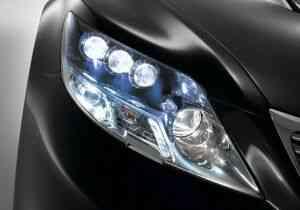Normally, the light efficiency (photoelectric conversion rate) LED lights is no less than 80lm/W, but the light efficiency of HID lamps can reach up to 90lm/W, halogen lights have even higher light efficiency 201lm/W. According to a recent report, the latest LED technology can increase the light efficiency into a higher level of 161lm/W, which was treated as a breakthrough of LED lighting technology. It is also estimated that in the next 3-5 years, LED light efficiency can be improved by 50% within the same power consuming range. This will not only means that LED lamps will be brighter, but also consumed much less power.

However, lamps with higher light intensity will generate more heat. And the compact arrangement of LED car lights will exacerbate this problem. Even as semiconductor, LEDs produce much less heat than halogen lamps and HID lamps do. But the problem is, heat generated by halogen lamps and HID lamps is usually in the outside of lamps while the tiny heat generated by LED devices is concentrated within chips. Special cooling sections need to be used to conduct all these heat outwards.
Even ignorable heat concentrating onto the small-sized chips still dramatically increases the LED chip temperature due to the limited thermal capacity. The working temperature of LED should keep under 150℃. One solution for this problem is: using multiple LED chips within on lamp, reducing the thermal generation of single chip. Then arrange them in a relatively large space to help dissipating heat. It is an approach that adopted by Koito on Toyota Lexus LS600h series.
According to one manager of Hella, thermal dissipation is one of the most difficult parts of virtual design of LED car lights. The usual process is evaluation and optimization through related simulation software. The selection of simulation package must base on a large amount of experiment results. Challenges from thermal dissipation not only from heat conduction (transfer all heat outwards through “hot pool”), but also ventilation problems. Obviously, natural ventilation is far less enough, so designers from Hella decided to use built-in fans.
Valeo applied another set of thermal management strategy: they set a safe working mode for LED car lights. When the temperature raise to a predetermined value (alert), the control system will automatically turned into the safe mode by cutting the power by 20%. This will cause tiny influence to the brightness of LED lamps, but can effectively maintain the working temperature in a normal level.
